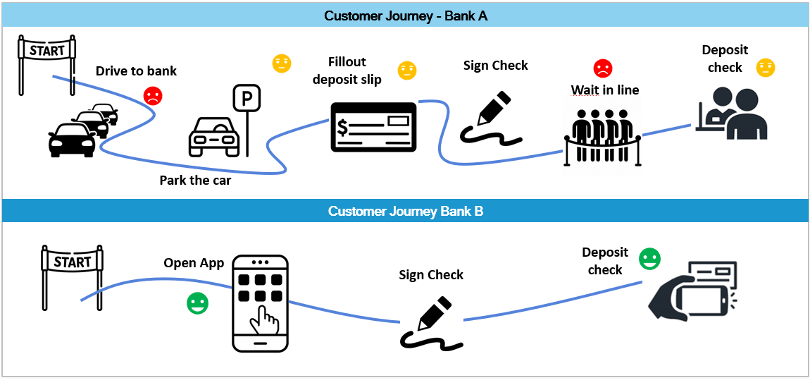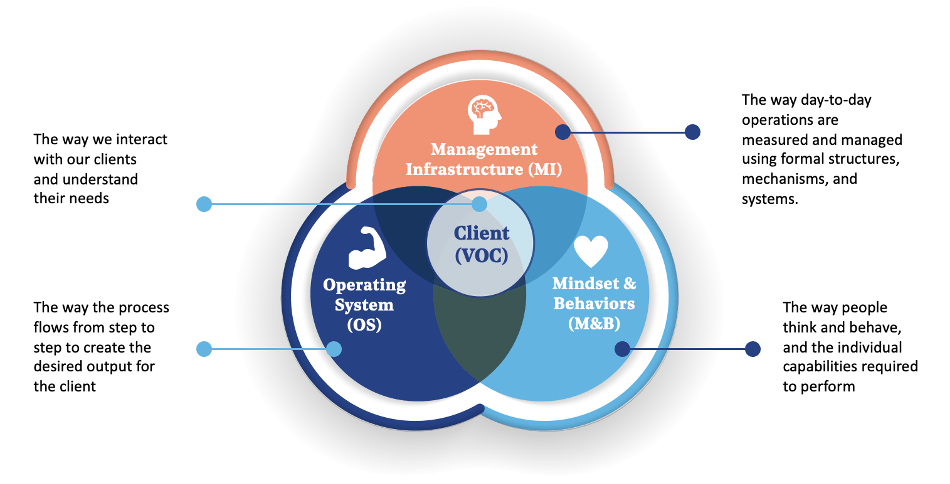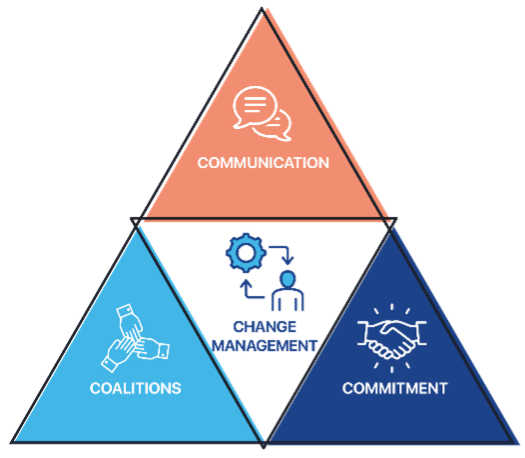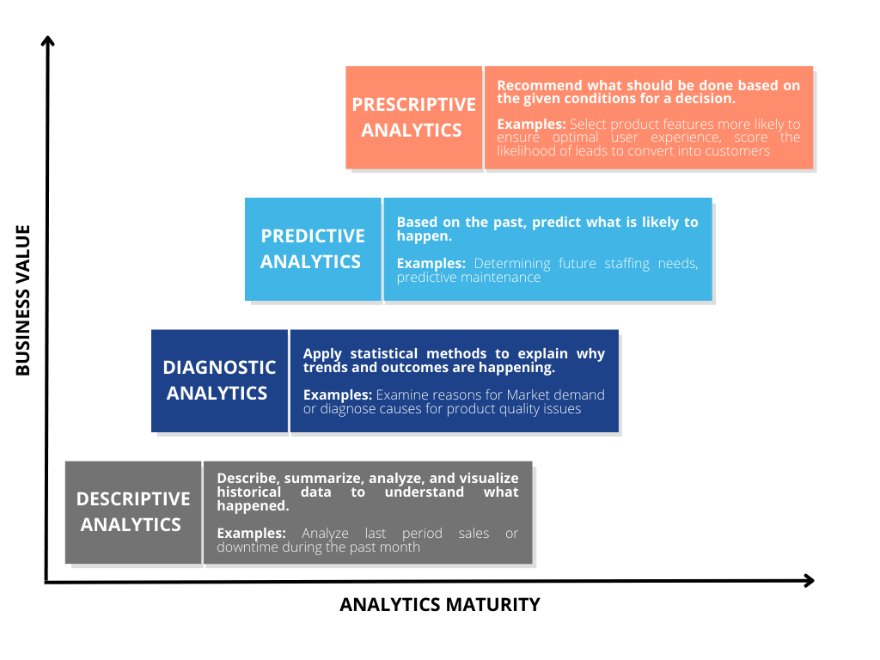Overview
What is Digital Transformation?
Digital Transformation is about delivering value to the business by integrating digital solutions where it has the biggest impact. That value can be delivered internally, like digitally reengineering the backend operations of a public entity, or externally, like improving the customer journey on a service organization.
Digital transformation initiatives can be challenging due to deficiencies in the IT infrastructure, lack of specialized technical skills, elevated upfront cost, resistance to change and uncertainty about the path to follow and level of success. It’s not uncommon to find siloed digitalization initiatives in the absence of an integrated digital transformation strategy. To achieve successful digital transformation initiatives, a company must assess its level of digital maturity to map a solid strategy that includes its people, culture, infrastructure, and processes.
One of the initial steps in the digital transformation journey is process automation, allowing the business to achieve operational efficiencies and increase customer satisfaction, while setting the stage for deeper and more sophisticated changes. Process automation initiatives tend to have the biggest impact when certain conditions are met, including but not limited to:
• There’s an urgent need to improve the customer experience, as evidenced by low Net Promoter Scores, a rise customer complaints and increased competitive pressure.
• The operation is broken and coped with obsolete and highly manual processes that result in waste, long cycle times and inefficient resource utilization.
• A weak management infrastructure that lacks visibility on the key performance indicators and is in urgent need of analytical tools to visualize key business drivers.
How to achieve a successful process automation?
To increase the rate of success in process automation initiatives, and in the digital transformation of the whole organization, there are 5 key elements to consider:
1. Identify the client’s pain points and value drivers
2. Optimize the process before transforming it
3. Design the digital solution with the user in mind
4. Support users with a solid change management strategy
5. Unleash the power of Analytics
1st – Identify the client’s pain points and value drivers
It’s important to internalize that a digital transformation is not only about digitalizing a process. It requires assessing the landscape in the organization and a deep understanding of the customer’s voice and pain points across the journeys. Failing to do so will result in a digital solution full of non-value-adding features.
Let’s consider a customer journey example where a person wants to deposit a check in the fastest way possible. Bank A requires her to drive to the closest branch, park the car, walk to the location, wait in line, ask for a pen, fill out the deposit form, hand the check to the teller and return to the car. On the other hand, Bank B, allows for online check deposits using your mobile phone. Understanding the customer journey is the first step to identifying the pain points that should be solved through digital transformation. Prioritizing the most impactful initiatives to improve the customer experience comes next.

Journey mapping is a very powerful tool that we use in V2A Consulting to diagnose the voice of the customer and help . It also helps identify the client pain points and prioritize process improvements by focusing on digital solutions that result in the biggest impact and value creation.
2nd – Optimize the process before transforming it
Too often, we see companies that decide to digitalize or automate a process without optimizing it. This approach results in costly failures. Other companies make the mistake of changing their processes to fit a certain tech solution and using workarounds. In the end, digitalizing an inefficient and broken process is not the best approach.
In V2A, we integrate our digital transformation projects to ensure successful optimization. This methodology helps to effectively diagnose and recommend improvements to any process centered around the Voice of the Client (VoC), or the specific needs and wants of the end-users. It provides the tools to identify gaps in 3 main pillars:
- Operating System (OS) – the way the process flows from step to step to create the desired output.
- Management Infrastructure (MI) – the way day-to-day operations are measured and managed using formal structures, mechanisms, and systems.
- Mindset & Behaviors (M&B) – the way people think and behave, and the individual capabilities required to perform.
We work with the organization to clearly understand the current processes and necessary tools to deliver on the service promise. Sustained operational improvements, waste reduction, and reduced cycle times are achieved aligning operating systems, management infrastructure and mindsets & behaviors with a focus around the customer. The figure below summarizes V2A’s LEAN Management framework and how each pillar relates not only to daily operations but to the client.

3rd – Design digital solution with user in mind
Designing to improve the User Interface and User Experience (UI/UX) is the most critical element. An optimal design helps reduce or eliminate client pain points, bottlenecks, rework, manual labor, and any other issue that impacts the User Experience identified using the LEAN framework. To facilitate the digital design, wireframes are used to visualize the desired solutions and user requirements. Users can then interact with these wireframes and provide feedback, ensuring that the design is heading in the right direction and before the developers invest time in full mockups of the User Interface. It is critical that the users are always at the center of this design process. Valuable development hours can be wasted on a solution that does not satisfy the ever-changing needs of the users. Short feedback loops with the users will go a long way in guaranteeing that an optimal solution is developed.

4th – Support users with a solid change management strategy
Once the desired solution has been developed and tested, the organization is ready to launch a robust deployment and training plan. To realize the full value of the solution, it needs to be rolled out across the business behind a solid change management strategy. Successful transformations need to consider the key pillars of change management: communication, commitment and coalitions. Formal mechanisms need to be established to capture user feedback and their evolving needs. To learn more regarding V2A’s Change Management Methodology, we encourage you to read our Insight titled “Adopting change in times of change.” .

5th – Unleash the power of Analytics
In addition to delivering value through operational improvements, digital transformation increases the availability and timeliness of data about the business, its processes, customers, and resources. To maximize the potential benefit of said data, the design of the digital solution must include good data architecture practices, to ensure it can be easily accessed and consumed for present and future analytics solutions.
Applying analytics improves decision-making and the capacity to identify and track process improvements. Resulting in improved stakeholders’ satisfaction.
For this reason, data analytics should be the focus and guide for the subsequent phases of the digital transformation journey. The level of sophistication and maturity of a company, in terms of data management and IT capabilities, will define its starting position in the analytics path and how fast it can transition from looking into the past and understanding what already happened through business intelligence, to looking into the future with advanced analytics, applying predictive modeling and prescribing analytics to make better and timely business decisions.
Types of Analytics Solutions

As with digital transformation, multiple use cases exist on how to apply data analytics in strategic, operational or support functions in businesses across industries. However, each business has characteristics that can translate into specific challenges when implementing analytics solutions. Additionally, not all processes or business areas will require the same level of data analytics to achieve a significant and cost-efficient business value increase. Emphasis should be in identifying the use cases that will deliver the best value-effort relation and a roadmap to address the enablers required for each type of solution.
The path to digital transformation
It’s never too late to embark on a digital transformation journey. In order to obtain the benefits of a digital transformation, organizations should focus on improving the value they offer to their customers. By doing so, they can create a competitive advantage that enables them to stay ahead of the curve in today’s landscape. Improving your customer journey by eliminating pain points, reducing cycle times and waste, while providing visibility on key metrics through analytics, will position your business for the future.
In V2A, we have successfully helped several clients in their digital transformation initiatives. Please visit this link for further information about this fascinating trend: https://v2aconsulting.com/operations/.
Disclaimer
Accuracy and Currency of Information: Information throughout this “Insight” is obtained from sources which we believe are reliable, but we do not warrant or guarantee the timeliness or accuracy of this information. While the information is considered to be true and correct at the date of publication, changes in circumstances after the time of publication may impact the accuracy of the information. The information may change without notice and V2A is not in any way liable for the accuracy of any information printed and stored, or in any way interpreted and used by a user.
ONLY ENGLISH VERSION
